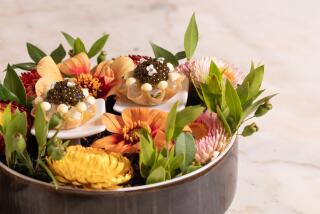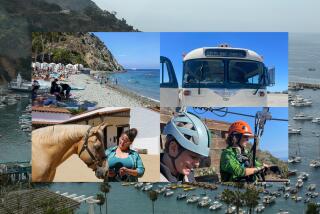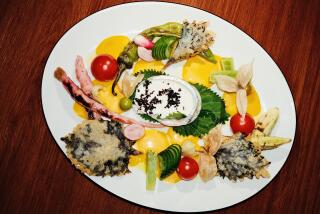Waltzing into magical Avignon
Avignon, France
We danced on the bridge at Avignon, my wife, Sandy, and I, an improvised two-step to the familiar French song “Sur le Pont d’Avignon.” The ditty was one reason we came to this ancient walled city in southern France, most noted historically as the 14th century residence of nine popes.
How could we not dance? At the entrance to the bridge, which dates to the 12th century, we had picked up audiophones. For about 15 minutes, a recorded voice directed us on a stroll atop the remnant of this graceful stone monument, detailing its many legends. Then, as we stood watching the Rhone River flow far beneath us, the narration concluded with a lively choral rendition of the tune. It seemed an invitation.
I linked arms with Sandy, and we whirled across the stones to the music, each holding an audiophone to an ear. Our spontaneous show did, of course, create a minor scene, but sightseers seemed sympathetic, nodding and smiling as we took a final spin.
Sandy learned “Sur le Pont d’Avignon” in a high school French class, which put the bridge and Avignon on her travel wish list.
In Avignon there is more to celebrate than the renowned bridge. The city, a gateway to Provence, has a reputation as one of Europe’s best-preserved architectural gems and was classified as a World Heritage Site by UNESCO in 1995. It is graced with dozens of splendid historical structures, many open to the public. Dating from the Roman, medieval, Renaissance and Napoleonic eras, they form a grand outdoor museum of the past. The most illustrious is the towering 14th century Palace of the Popes, commanding a view of the city from a hillside perch. At night, under spotlights, it glows like a full moon.
We arrived here from Paris on France’s high-speed TGV train in only 2 hours and 40 minutes — the journey takes seven hours by car — and checked into the luxurious 80-room Hôtel Clarion Cloître Saint Louis, a restored 16th century Jesuit school off Rue de la République. The hotel, wrapped around a formal courtyard shaded with tall plane trees, blends the allure of an ancient structure with the chic contemporary furnishings found in new boutique hotels. I loved our spacious room and its mammoth windows, but the ultramodern chairs were uncomfortable.
A palace of papal pomp
Our first destination the next morning was Avignon’s bridge. Imagine my surprise when I discovered it leads nowhere. Once 22 arches spanned the Rhone; now only four carry the bridge from the city’s northern rampart to the middle of the river. The often-flooding Rhone ripped away one arch after another through the decades. Still, the bridge looks rather stately despite its wounds.For a $3.50 fee, visitors can walk its remaining length, and from its mid-river terminus the view back to the city, its wall, the cliff and the papal palace is spectacular. The span’s official label is Pont Saint-Bénézet, named for a shepherd boy who, in 1177, claimed to have heard a voice from heaven instructing him to build a bridge here.
After our dance, Sandy and I climbed the spiraling staircase that ascends the sheer cliff rising above the Rhone. It leads to the Rocher des Doms, an elaborate 19th century garden of splashing fountains, classical statuary, a rock grotto and a pond with gliding swans. From this height, panoramic views extend across the Rhone to a massive medieval fort in the suburban town of Villenueve-lez-Avignon. Zigzagging walkways and stairs descend from the garden to the fortress-like papal palace, its crenelated walls and twin spires a city landmark. A guard in colorful 14th century garb of feathered hat, striped pantaloons and sword greeted us and agreed to Sandy’s request for a photo.
From outside, the palace looks unconquerable. Inside it reflects great wealth. Rich tapestries decorate many walls, and other rooms are adorned with lovely frescoes. Ceremonial rooms such as the Hall of the Consistory, where the popes received kings and ambassadors, are enormous and ornate. But the finest room is the Pope’s Bedchamber; its soaring walls are covered with a sky-blue fresco of birds and squirrels amid grapevines. The floor is a patchwork of multicolored tiles.
The palace opens onto the Place du Palais, where a cluster of outdoor cafes provides a fine view of the palace walls. We ate a light lunch here at the improbably named In & Off, choosing a plate called Specialties of Provence. Touristy, we feared, but it turned out to be a tasty arrangement of eggplant tapenade, a selection of pâtés, sun-dried tomatoes and roasted peppers.
Sandy and I have found Europe’s smaller cities to be as rewarding as the national capitals, and Avignon offered all the pleasures of Paris but without the clamoring traffic and — dare I admit it? — the pressure to take in all the capital’s many notable museums and churches. Here the list of must-see sights can be done in a couple of days, and nearly every one is within a 20-minute walk.
As dutiful sightseers, we visited the city’s important monuments and several of its more modest museums. On the Place du Palais we took in the Petit Palais Museum, which houses a collection of Italian Renaissance paintings in a 14th century cardinal’s residence. More to my liking were the Impressionist works (by Manet, Sisley, Utrillo, Dufy) at the Calvet Museum, which occupies an 18th century manor house regarded as the finest in Avignon. At Collection Lambert en Avignon, the Museum of Contemporary Art, we returned to the 21st century of flashing lights, video screens and fog machines creating I’m not sure what. A nearby antidote was the Louis Vouland Museum, filled with 18th century decorative arts — especially those of Provence. It may seem like a lot of museum-going, but these are small places, requiring no more than 30 to 45 minutes each.
We browsed shops specializing in colorful Provençal pottery and fabrics. The most interesting shops were on Rue Joseph Vernet, where Souliado offers an extensive selection of Provençal fabrics, tableware and scarves, and Rue des Marchands, where Les Olivades features an array of local designs. At La Cure Gourmande, a gourmet cookie store nearby, a clerk reprimanded me when I reached with a bare hand for a tempting treat.
“Use a plastic glove,” she snapped, aghast at the poor manners of her American customer.
I sought out another local confection, papalines, chocolate truffles filled with a liqueur distilled from 60 herbs picked from the slopes of Mt. Ventoux, a peak visible from Rocher des Doms. I found papalines at Pâtisserie La Tropérienne on Rue St. Agricol and gave them a try. One was enough: They tasted like perfume, so we left the rest for the hotel housekeeper.
But nearly everything else we ate was magnificent, especially our meals of modern French cuisine, with light sauces, fresh local vegetables and a good choice of fish entrees. And every night we sipped fine Côtes du Rhône wines. No wonder we felt like dancing “sur le Pont d’Avignon.”
A Christian capital
Historians believe Avignon has been occupied continuously for 5,000 years, and much archeological evidence has been uncovered of its status as a Roman colony, beginning in the 2nd century. Place de l’Horloge, where city hall stands, was the site of a Roman forum.The riverside market town attained lasting fame in 1309, when anarchy in Rome induced Pope Clement V, a Frenchman, to seek sanctuary here. For 70 years the little city-republic served as the capital of Christianity. Popes and cardinals commissioned lavish palaces. Though the popes returned to Rome, Avignon continued to flourish as a European market crossroads. But now Renaissance merchants built the palaces.
Until the 19th century Avignon remained medieval in appearance. Then, under the reign of Napoleon III, the city underwent much of the same redevelopment — new parks and wide streets — that Baron Haussmann, a financier and city planner, designed for Paris. Today, Avignon’s core is home to about 11,000 residents; an additional 75,000 live outside its walls.
Old though it is, Avignon seems young in spirit. Its streets are as lively at night as those in Paris. The city, a university center, is attracting a burgeoning colony of artists, whose contemporary works we admired (or puzzled over) in numerous galleries. Lines formed nightly outside the movie theaters on busy, tree-lined Rue de la République, the old city’s main thoroughfare.
It was early evening on a warm Saturday, and the street was thronged. Cafes and bars, indoors and out, were packed. All Provence, it seemed, had come to town to party. Our destination for dinner was the Hôtel de la Mirande, a four-star lodging tucked behind the papal palace. The restored 700-year-old town house is furnished with polished woods and rich tapestries of the past.
Our meal there was one of five memorable ones in Avignon. We ordered the fixed-price dinner at $47 per person. A menu in English described the appetizer as a “tower of beans,” which proved to be a salad of mixed beans, goat cheese and basil wrapped in a roasted red pepper. The main course, pan-roasted cod served with au gratin potatoes and fried spinach, was well prepared. We finished with apple cream cake and vanilla ice cream. Service was impeccable, and we left satisfied.
Even at 11 p.m., the streets were busy as we strolled back to our hotel. In the Place de l’Horloge, children and their parents lined up at a carousel. The open-air cafes were thronged.
Near the end of our stay, we returned to La Mirande for a chef’s dinner prepared before us in the restaurant’s 19th century kitchen, now a museum of sorts. These reservation-only dinners are offered to a maximum of 14 people on Tuesdays and Wednesdays, when La Mirande’s modern kitchen is closed. The meal is cooked in old Provençal style in pots on a wood-burning stove.
Our group of 12 — all food-loving Americans — sat around a large table in a small basement room. Jérôme Verrière, the young sous-chef at La Mirande, assumed command of his cast-iron stove, describing each dish as he effortlessly created it.
We began with fresh tuna, sautéed quickly with a balsamic vinegar glaze in a large copper pan. Next came a cold appetizer, foie gras with rhubarb marmalade. Venison in a parsley sauce proved popular as the entree. For dessert: a large cheese plate followed by baba au rhum, a rum-soaked sponge cake. Afterward we adjourned to the lobby for coffee and conversation.
After a feast like this, I felt like dancing again sur le Pont d’Avignon.
*
(BEGIN TEXT OF INFOBOX)
An appetite for delight in Avignon
GETTING THERE:
From LAX, Air France and Air Tahiti Nui offer nonstop flights to Paris. American, Northwest, Continental, United, Swiss, Lufthansa, KLM, Delta and US Airways have connecting service (change of plane). Restricted round-trip fares begin at $1,097.
From Paris, take the high-speed TGV train from Gare de Lyon to Avignon. The trip takes 2 hours and 40 minutes. Fare is about $73.
TELEPHONES:
To call the numbers below from the U.S., dial 011 (the international dialing code), 33 (country code for France) and the local number.
WHERE TO STAY:
Hôtel Clarion Cloître Saint Louis, 20 Rue du Portail Boquier, 84000 Avignon; 490-275-555, fax 490-822-401, https://www.cloitre-saint-louis.com . April-October, $130-$275 a night double; November-March, $84-$214. Our room, which overlooked the courtyard, was $214.
La Mirande, 4 Place de La Mirande, 84000 Avignon; 490-859-393, fax 490-862-685, https://www.la-mirande.fr . April-October, $300-$940 a night double; November-March, $260-$830.
Hôtel d’Europe, 12 Place Crillon, 84000 Avignon; 490-147-676, fax 490-147-671, https://www.hotel-d-europe.fr . Doubles $120-$670.
Kyriad Avignon Centre, 26 Place de l’Horloge, 84000 Avignon; 490-822-145, fax 490-829-092, https://www.kyriad.fr . Doubles $73-$82.
Ibis Avignon Centre Gare, 42 Boulevard Saint-Roch, 84000 Avignon (just outside the walls); 490-853-838, fax 490-864-481, https://www.ibishotel.com . Doubles $72-$104.
WHERE TO EAT:
We sought out Avignon’s upscale contemporary restaurants, enjoying mostly fish served with fresh local vegetables.
At La Mirande (see above), the most elegant, the chef’s menu was $55 per person.
We were also delighted by these less formal places:
La Compagnie des Comptoirs, 83 Rue Joseph Vernet; 490-859-904. I ordered a baked white fish ($17) wrapped in a banana leaf; Sandy went for the grilled lamb chop with eggplant ($22). We also ordered a green salad with figs, almonds and raisins ($8). Contemporary décor.
L’Isle Sonnante, 7 Rue Racine; 490-825-601. This small, nonsmoking restaurant serves a four-course fixed-priced meal for $58. Shrimp gratinée was the starter course, followed by a sautéed fillet of red mullet, the cheese plate and cookies with sorbet.
TO LEARN MORE:
Office de Tourisme d’Avignon, 41 Cours Jean Jaurès, BP 8, 84004 Avignon, Cedex 1, France; 432-743-274, fax 490-829-503, https://www.avignon-tourisme.com .
French Government Tourist Office, 9454 Wilshire Blvd., Suite 210, Beverly Hills, CA 90212; France-on-Call hotline (410) 286-8310 (for brochures) or (310) 271-6665, fax (310) 276-2835, https://www.franceguide.com .
— James T. Yenckel
James T. Yenckel is formerly a writer for the Washington Post.
More to Read
Sign up for The Wild
We’ll help you find the best places to hike, bike and run, as well as the perfect silent spots for meditation and yoga.
You may occasionally receive promotional content from the Los Angeles Times.






